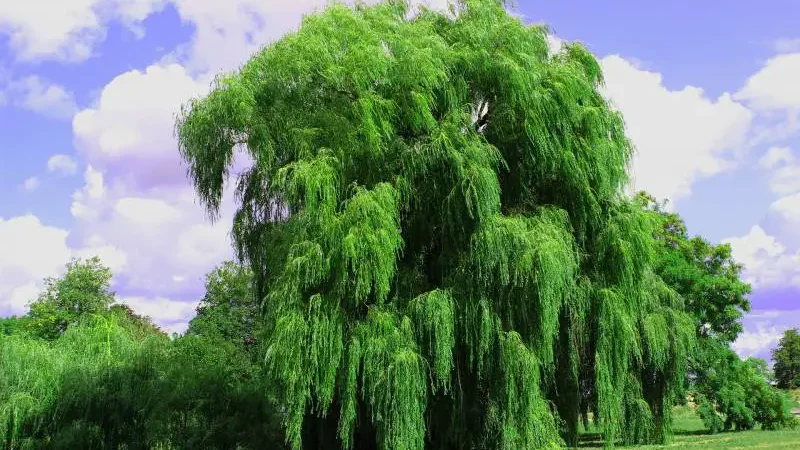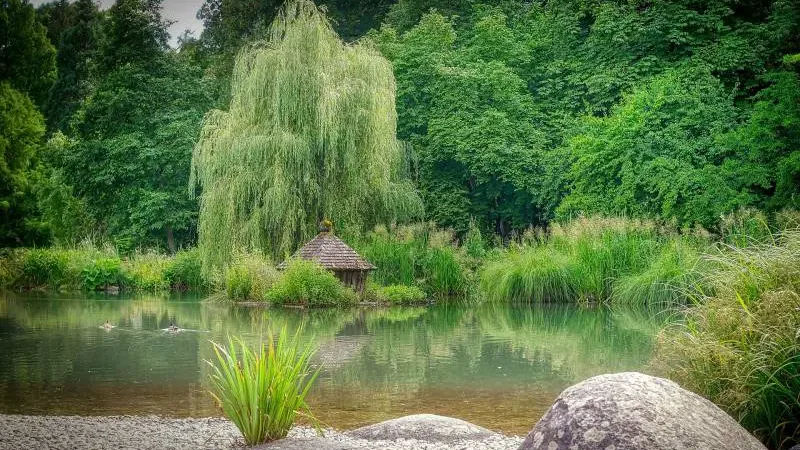How To Make A Weeping Willow Tree Grow Faster

The weeping willow tree beautifies your landscape and creates shade in the hot summer. It can also provide shelter for birds and wildlife.
The tree grows well if planted on a wide lawn or close to a water body, such as a lake, pond, or stream bank. If you plan on planting a willow tree and want it to grow faster, then you’re in the right place.
Weeping willow (Salix babylonica) trees are native to China and central Asia. This deciduous perennial tree is the most popular among plant weeping willow trees.
It features lance-shaped leaves that grow 3 to 6 inches long. Besides, the green leaves turn yellow in the fall before dropping. Additionally, the tree has a rough and gray bark with long, deep ridges.
The weeping willow creates lovely scenery in late winter or spring when it blooms by producing beautiful yellow catkins.
The weeping willow is one of the fastest growing trees on the planet. It can grow up to 24 inches or 2 feet in one year. It grows up to a maximum height of between 30 and 50 feet.
The trees reach full growth in 15 years. They have a lifespan of 30 years but can live up to 50 years if looked after properly.
Without much ado, let’s look at how you can bolster up your weeping willow tree to grow faster than usual.
Grow Near A Water Body
A weeping willow tree needs the right conditions to grow. Like most plants, proper drainage is crucial. But unlike most plants, willow trees grow faster and better in standing water.
That’s why most of them are grown close to water bodies, such as rivers, streams, ponds, or even lakes. Weeping willows love low areas that are waterlogged as they will use up the moisture.
This plant’s roots can soak up all the extra water and turn a swampy area into usable arable land again. Thanks to its far-reaching root systems.
Therefore, if you have an area in your compound that is soaked up with water, a willow tree can help you to clear up the water. But if you’ve planted your tree in an area without proper drainage or close to a water body, you will need to water it.
It’s recommended to water the tree weekly during the first year of planting. This will boost its growth. And if you want your tree to continue to fast growing even after the first year, you should continue watering it.
Enough Sunlight
Another important thing that the willow tree need is sunlight. Even though willow trees don’t require a lot of sunlight to grow, you should not plant them in full shade.
These trees need at least 4 hours of daily direct, unfiltered sunlight in order to thrive, as they thrive in full sun to partial shade. Nonetheless, they can tolerate both cold and hot temperatures.
But for them to grow well and rapidly, they need at least four hours of daylight.
Plant Right
Any plant that isn’t grown within its favorable conditions will have issues growing. That’s the same case with a weeping willow tree. The weeping willow tree can still grow if the conditions are not right, but it will have stunted growth.
This tree grows best in U.S Hardiness zones of 4 to 9. They require full sunlight to grow, but they grow best in partial shade and sunny areas.
Make sure it gets four hours of sunlight and proper drainage to grow faster. The soil should have good drainage. They really favor soils that are moist, well-draining, and slightly acidic. Sulfur can be added to your soil to make it more acidic if it is too alkaline.
However, if it’s exceptionally alkaline, add some organic matter to lower the pH level. Dig a deep hole twice the depth and width of the root ball of the weeping willow tree. Place the tree in the hole and make sure it’s straight. Avoid putting fertilizer, manure, or compost in the hole. Then, fill the hole with half the soil, add water, and finally fill the remaining half with soil.
Add mulch at the base of the tree to keep away weeds. You don’t want weeds to compete for nutrients with your young weeping willow tree. Use bark mulch as it’s the best option.
Lastly, don’t forget that there’s a minimum of 50 feet should separate your home from the weeping willow you plant.
Keep Away Pests And Diseases
The presence of a weeping willow tree in your landscape has benefits and drawbacks, just like any other plant.
After planting your tree, watch out for pests and diseases. These may not only slow down the growth rate of your tree but as well as kill it. Weeping willows are prone to mildew, fungi, and root rot because they are frequently grown in wet environments and thrive there.
Common weeping willow pests are aphids, gypsy moths, and borers. Weeping willows rarely contract a disease.
However, these are the few common weeping willow diseases: willow blight, root rot, willow scab, crown gall, powdery mildew, black canker, and leaf spots. The removal of infected tree parts can, however, prevent or treat all of these conditions.
If you deter these pests and diseases from affecting your tree’s growth, it will grow rapidly.

Pruning
The best way to make a weeping willow tree grow faster is through pruning. When you prune your willow tree, you get rid of the dead and decaying branches and stubs. As a result, it discourages pest and animal infestation and support’s the plant’s healthy growth.
Prune your willow tree while it’s still young, with one central leader being cut for the best growth. This will help it to develop a strong central trunk. After all, willow trees are strong and will defy a lot of pruning.
A pruned willow tree can grow up to 3 to 4 feet in a single year. This is faster than their usual growth rate of 2 feet a year. When it comes to pruning, you should prune your willow tree in the right way.
Get rid of large shoots that grow up close to the base and from the tree’s original trunk. This will form one strong central trunk, instead of forming several thick branches at the center of the tree. Aside from pruning large shoots, you should also get rid of the suckers.
These typically emerge from the base or the roots of the weeping willow plant. Identify where the sucker is originating from, even if it means removing some top layer. Rip up every sucker away from its base instead of cutting it so that you can destroy fibers and prevent them from re-growing.
Additionally, cut any branches that are too close to the ground. This will help to maintain its growth.
The best time to prune your tree is in the early spring before it blooms or in the late fall because it will stimulate the growth of new branches and revitalize your tree.
Bottom Line
If you intend to plant a weeping willow tree or already have one you want to grow faster, you can follow the above steps. A weeping willow tree requires rich & moist soil, somewhat acidic soil, four hours of sunlight, and good drainage to flourish. You should avoid planting it next to a septic tank, pool, or close to your house.
All the best as you make this deciduous plant grow faster!